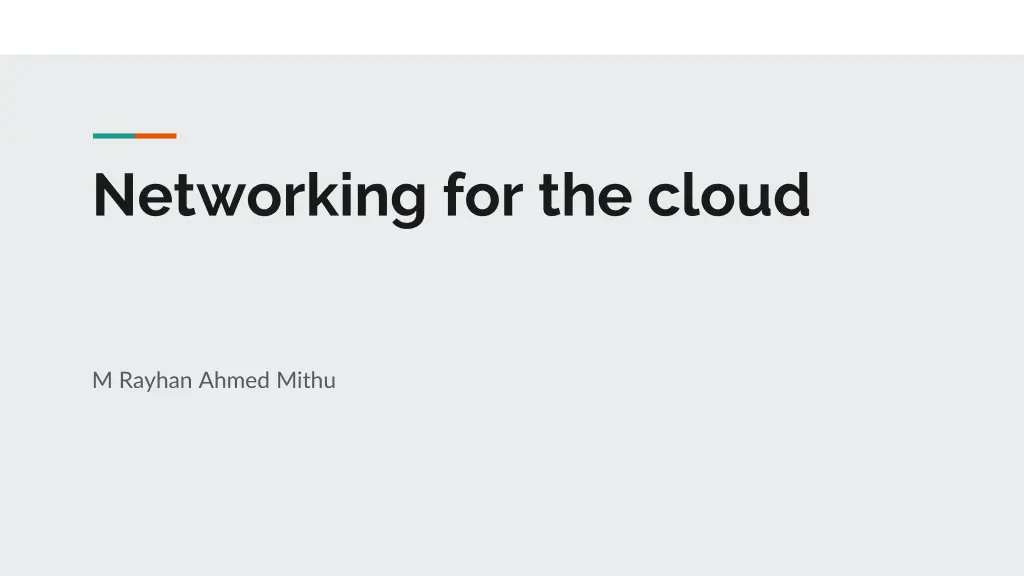
Cloud Computing Network Architecture and Future Trends
Explore the network architecture of cloud computing, security aspects, open issues, and the challenges of migrating to the cloud. Learn about the foundations of cloud computing, service models, and control comparison of different models. Discover the future trends in network architecture, focusing on resource allocation, fault tolerance, SDN, collaborative web scenarios, and more.
Download Presentation

Please find below an Image/Link to download the presentation.
The content on the website is provided AS IS for your information and personal use only. It may not be sold, licensed, or shared on other websites without obtaining consent from the author. If you encounter any issues during the download, it is possible that the publisher has removed the file from their server.
You are allowed to download the files provided on this website for personal or commercial use, subject to the condition that they are used lawfully. All files are the property of their respective owners.
The content on the website is provided AS IS for your information and personal use only. It may not be sold, licensed, or shared on other websites without obtaining consent from the author.
E N D
Presentation Transcript
Networking for the cloud M Rayhan Ahmed Mithu
Outline Research question Overview of cloud computing (CC) Network architecture of CC Security aspects Open issues Migrating to the cloud
Research question Moving to the cloud, why it is a challenge? What are the critical processes to migrate to cloud?
What is cloud computing?[1] Its a model that provides convenient and on-demand access to configurable computer resources such as neworks, servers, storage, applications and services to the end users with minimal management effort and interaction with the service providers (NIST).
CC service models [1] Software as a Service (Saas) Platform as a Service (Paas) Infrastructure as a Service (Iaas)
Control comparison of different models [1] SaaS PaaS IaaS
Network architecture [1] Reliable communications Reliable link protocol (FCoE) Avoid losing frames (IEEE 802.1Qbb) Avoid transmission loss (IEEE 802.1Qau) Congestion exposure mechanism Efficient communications Shortest Path Bridging (SPB) Transparent Interconnect of Lots of Links - TRILL Enhanced OSPF and BGP Virtual networking Software Defined Network (SDN) Elastic allocation, federation and interoperability
Future network trends [1] Solve tradeoff between resource allocation and fault tolerance Resource sharing Metrics to assess performance and energy efficiency SDN could help to study fully collaborative, peer-to-peer and pervasive web scenarios Cooperation in Cloud Computing Mobile Cloud Computing and Network Functions Virtualization; inter-Cloud Computing architectures Internet of Things
Security Aspects [1] Up to date security patches Data isolation Authentication and trust mechanisms Secure connection (VPN) Identify threats
Security Aspects (Model specific) [1] SaaS - inherits security drawbacks of web services PaaS - isolation between tenants and efficient resource usage IaaS - security of networking, virtualization and physical resources Security risks of emerging model Data as a service.
Cloud adoption factors [2] Virtualization Security and privacy Interoperability Service-level agreement Organizational context
Cloud adoption/migration framework [2]
Required measures for migration [3]
Opportunities advantages of migration [3] Adaptable IT resources Cost-saving solutions Security features Manage incomings and outgoings Develop new skillsets Organizational development
Challenges of migration [2,3] Choosing the right vendor Trust in cloud security Departmental downsizing Lack of supplementary resources Lack of prior knowledge could result in failure
Critical process of migration [4] Plan phase Design phase Enable phase
Plan Phase [4] Analyse context Analyse requirements Identify system Define plan
Design phase [4] Design cloud solution Choose platform Identify incompatibilities Design principles
Enable phase [4] Resolve incompatibilities Encrypt/Decrypt entities Deploy system components Configure network Isolate tennant Rebalance system Enable elasticity Deploy system Test system
Conclusion Cloud computing offers a lot There are still open issues and concerns Migrating requires in depth analysis
Reference 1. Moura, J. and Hutchison, D., 2016. Review and analysis of networking challenges in cloud computing. Journal of Network and Computer Applications, 60, pp.113-129. Amin, R., Vadlamudi, S. and Rahaman, M.M., 2021. Opportunities and challenges of data migration in cloud. Engineering International, 9(1), pp.41-50. Shuaib, M., Samad, A., Alam, S. and Siddiqui, S.T., 2019. Why adopting cloud is still a challenge? A review on issues and challenges for cloud migration in organizations. Ambient Communications and Computer Systems, pp.387-399. Gholami, M.F., Daneshgar, F., Beydoun, G. and Rabhi, F., 2017. Challenges in migrating legacy software systems to the cloud an empirical study. Information Systems, 67, pp.100-113. 2. 3. 4.
